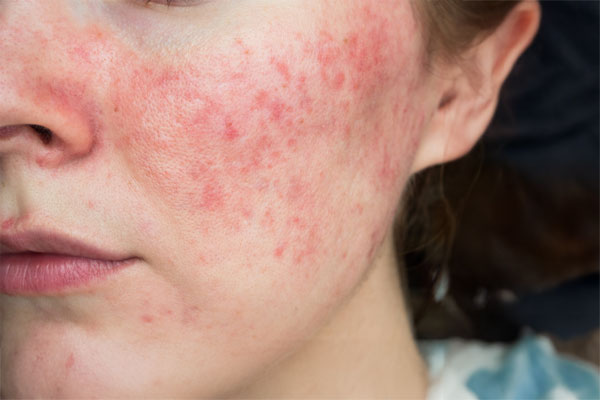
Rosacea is a common skin condition that can vary in severity and presentation. While it is a chronic condition, a range of treatment options are available to help manage symptoms.
At Complete Skin Specialists, our dermatologists, dermal therapists, and cosmetic nurses work together to offer individualised rosacea care. This may include skin care recommendations, prescription treatments, and laser-based therapies to support the management of redness, visible capillaries, and facial flushing.

Rosacea is a common skin condition that causes redness, flushing, and sensitivity, particularly on the face. It may also include red bumps, pimple-like breakouts, and visible blood vessels (capillaries). Over time, the skin can become more irritated and inflamed.
The exact cause of rosacea is not fully understood, but early diagnosis and treatment may assist in managing symptoms and reducing the likelihood of progression.
Rosacea is most common in people with fair skin, particularly those of English or Irish heritage. It is more frequently seen in women aged 30 to 50, but men and even teenagers can also develop it. In some cases, hormonal changes, such as those experienced during menopause, may play a role.
Rosacea symptoms can vary, but common signs include:
For some, rosacea worsens over time. Initially, redness may come and go, but without treatment, it can become more persistent. In severe cases, a condition called rhinophyma may develop, where thickened skin and enlarged oil glands cause the nose to appear bulbous.
This occurs more commonly in women and may require laser or surgical treatment.
Rosacea can present in different ways, and it is classified into four main subtypes:
Rosacea triggers vary between individuals, but common factors include:
By identifying and avoiding triggers, you can help reduce flare-ups and maintain better control over your rosacea.
Treatment for rosacea is tailored to your symptoms, triggers, and skin type. Management typically focuses on three key areas:
Using gentle, rosacea-appropriate skincare and sun protection may help reduce irritation and support daily symptom management. Your clinician can offer guidance on suitable products as part of an individualised plan.
Laser-based treatments may be used to address visible blood vessels and persistent facial redness. Specific options, such as vascular lasers, can be discussed with your practitioner if appropriate for your skin. These therapies are typically offered as part of a longer-term management plan.
All treatments carry potential risks and benefits. A consultation with a qualified practitioner is required to assess suitability and discuss options.
A patient typically needs to see a Dermatologist for correct diagnosis (as there are various sub types of Rosacea), education on environmental and lifestyle triggers, and prescription Medication – such as antibiotics and topical soothing creams.
Following this, they are referred to dermal therapy team for skin care advice; correct skin care is essential in the management of Rosacea and incorrect cosmetic products can be a huge trigger for symptoms and irritation – we need to care for the skin and strengthen the barrier.
We then discuss vascular laser (Vbeam) to target redness, flushing and broken capillaries (main symptoms of Rosacea). We typically start with 3 lasers, 8 weeks apart.
We review the patient after each laser and again at 6 months.
Once their Rosacea is under control; they are referred to a maintenance plan where we recommend a Vbeam laser every 6-12 months.
*Please note, treatment pathways may vary depending on individual circumstances. This plan is a typical pathway.
Depending on where you’re at in your journey, you can book an appointment with our dermatology practice, or cosmetic practice.
Depending on individual circumstances, treatment options may include:
39 Station Street, Sunbury VIC 3429
Depending on individual circumstances, treatment options may include:
Building 1: 115 O’Shanassy Street, Sunbury VIC 3429
If you’re a new patient, you’ll be invited to attend an initial consult prior to your service to ensure it’s right for you.

See your GP to obtain a referral

Initial consult to discuss
skin concerns and goals

Receive a treatment plan to support your skin health

Expertise

Long Lasting Results

Healthier Skin